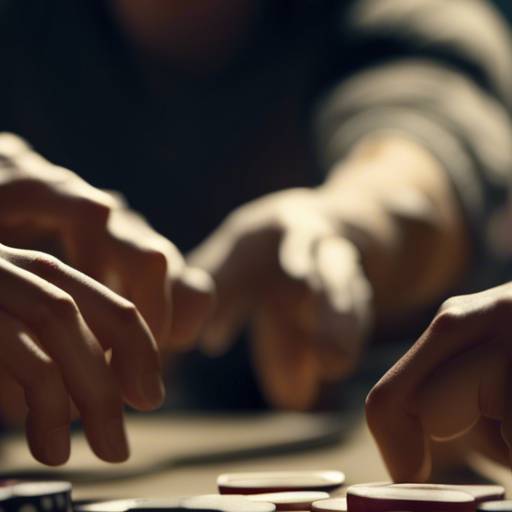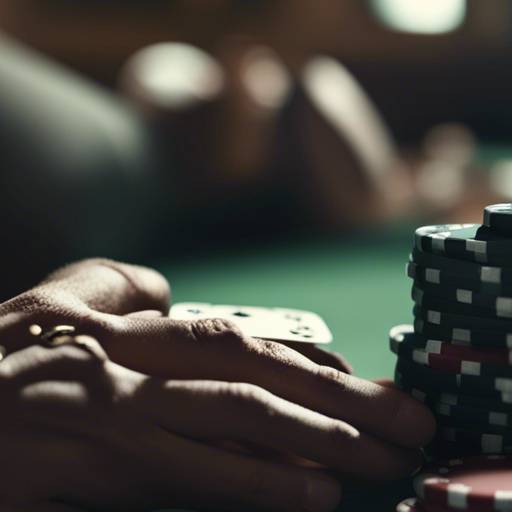Mastering the art of the poker face is a critical skill for any player looking to excel in Texas Hold’em live games. A poker face is an impassive expression that conceals one’s true feelings or intentions, particularly during a high-stakes game where non-verbal cues can give away the strength of a player’s hand. The ability to maintain a neutral demeanor prevents opponents from gaining insight into your strategy, thus providing a competitive edge. In the psychological battlefield of Texas Hold’em, where bluffing and misdirection are key tactics, a well-crafted poker face can be as valuable as the cards held. As players around the felt scrutinize each other for any sign of weakness or confidence, those who have honed this skill can navigate the game with an air of unpredictability, keeping their adversaries guessing and capitalizing on the element of surprise.
Perfecting Your Poker Face: Essential Tips for Texas Hold’em Live Success

Mastering the Art of the Poker Face in Texas Hold’em Live Games
In the high-stakes world of Texas Hold’em, success hinges not just on the luck of the draw but also on the subtle art of deception. A poker face, that inscrutable expression shielding your true emotions and intentions, is an invaluable asset in live games. It’s the armor that protects your strategy from prying eyes, the veil that cloaks your excitement when you’re holding a royal flush or your dismay at a poor hand. To ascend the ranks in Texas Hold’em live games, perfecting your poker face is not just recommended; it’s essential.
The first step in cultivating an effective poker face is understanding its purpose. In live games, where opponents are keenly observing each other for any telltale signs, a poker face serves as a constant, unchanging facade. It’s about maintaining composure, whether you’re on the verge of a win or facing down a loss. This emotional control is critical because even the slightest twitch or grimace can betray your position.
To achieve this level of control, start by practicing relaxation techniques. Deep breathing exercises can help steady your nerves and keep your reactions in check. By focusing on your breath, you create a rhythm that not only calms your mind but also anchors your facial expressions in neutrality. This calm demeanor will be your greatest ally when the pressure mounts and the stakes are high.
Another key aspect of a poker face is eye contact. While it’s important to observe your opponents, it’s equally crucial to do so without revealing anything about your hand. Maintain steady, confident eye contact that doesn’t linger too long or dart around suspiciously. A gaze that’s too intense can be just as revealing as one that’s too evasive. Striking the right balance is a subtle but powerful way to keep your opponents guessing.
Moreover, consistency is the cornerstone of a good poker face. Whether you’re folding or betting big, your expressions and body language should remain uniform. This consistency extends to your patterns of speech and movement. By standardizing your behavior, you make it incredibly difficult for others to read your play. Remember, predictability in your demeanor is an advantage, but predictability in your gameplay is not.
It’s also important to be aware of your own tells. Everyone has them, and part of perfecting your poker face is learning what yours are and how to conceal them. This self-awareness can be honed through practice and, if possible, by reviewing footage of your past games. Once you know your weaknesses, you can work diligently to eliminate them or, better yet, use them to your advantage by deliberately sending false signals to throw off your opponents.
Lastly, don’t underestimate the power of mental fortitude. A strong poker face is as much about psychological strength as it is about physical control. Cultivating a mindset that doesn’t waver with the ebb and flow of the game will reinforce your external composure. It’s about being unfazed by the outcome of each hand and staying focused on the long game.
In conclusion, a poker face is more than just a blank expression; it’s a comprehensive strategy that encompasses physical control, behavioral consistency, and mental resilience. By mastering these elements, you’ll not only become a formidable opponent in Texas Hold’em live games but also gain a deeper appreciation for the psychological complexity of this timeless card game. So, take these tips to heart, practice diligently, and watch as your poker face becomes an impenetrable mask of strategy and skill.
Mastering the Art of the Poker Face in High-Stakes Texas Hold’em Live Games

Mastering the Art of the Poker Face in High-Stakes Texas Hold’em Live Games
In the high-stakes arena of Texas Hold’em live games, the ability to maintain a poker face is not just a skill, it’s an art form. A poker face goes beyond simply keeping a straight face; it’s about cultivating an impenetrable aura that shields your true emotions and intentions from your opponents. Whether you’re a seasoned pro or an enthusiastic amateur, understanding the nuances of this skill can significantly elevate your game.
The first step in mastering your poker face is to recognize its power. A well-maintained poker face can throw even the most experienced players off their game, creating a veil of mystery around your actions. It’s a psychological tool that, when used effectively, can lead to a significant advantage at the table. By presenting a calm and unreadable demeanor, you force your opponents to play the cards, not the player, which can lead to them making costly mistakes.
To develop a convincing poker face, start by controlling your physical reactions. This means being mindful of your facial expressions, body language, and even the tone of your voice. Small tells, such as a raised eyebrow, a quick glance at your chips, or a change in breathing patterns, can give away your hand’s strength or weakness. Practice in front of a mirror or with friends, and learn to neutralize these involuntary responses. The goal is to present a facade that is as impassive as it is inscrutable.
Moreover, consistency is key. Your demeanor should remain constant whether you’re holding a royal flush or a pair of twos. This level of control can be challenging to maintain, especially in the face of a potential big win or loss. However, with practice, you can learn to detach your emotions from the outcome of each hand, ensuring that your poker face remains steadfast throughout the game.
Another aspect of mastering the poker face is to be aware of your opponents’ behavior. While you’re working hard to conceal your own tells, be vigilant in spotting theirs. This dual focus not only helps you hide your own intentions but also enables you to gather valuable information about the other players at the table. By observing their patterns and reactions, you can make more informed decisions and turn the tables in your favor.
It’s also important to remember that the poker face is not just about defense; it’s an offensive strategy as well. By projecting confidence and calm, you can induce doubt and hesitation in your opponents. This psychological edge can lead to them folding when they might otherwise have stayed in the game, or to calling when they should have raised. Your poker face, therefore, becomes a subtle form of manipulation, guiding the flow of the game to your advantage.
In conclusion, the art of the poker face is a critical component of success in high-stakes Texas Hold’em live games. It requires discipline, practice, and a keen awareness of both your own behavior and that of your opponents. By mastering this skill, you not only protect your own hand but also gain a deeper insight into the game’s psychological landscape. So, the next time you sit down at the table, remember that your greatest asset may not be the cards you’re dealt, but the expression you wear while playing them. With a poker face that’s as much a work of art as it is a strategy, you’ll be well on your way to dominating the high-stakes poker scene.
The Psychology Behind a Winning Poker Face in Texas Hold’em Live Tournaments

Mastering the Art of the Poker Face in Texas Hold’em Live Games
In the high-stakes world of Texas Hold’em live tournaments, the ability to maintain a poker face is not just a skill—it’s an art form. A winning poker face can be the difference between triumph and defeat, as it conceals your intentions, misleads your opponents, and exudes an aura of confidence that can unnerve even the most seasoned players. The psychology behind a winning poker face is as intricate as the game itself, and mastering it can elevate your play to a level where you’re not just playing the cards, but you’re also playing the minds of those around you.
The cornerstone of a winning poker face is control. Control over your emotions, your reactions, and the information you inadvertently give away. In the heat of a game, it’s natural for your heart to race at the sight of a strong hand or for panic to set in when the odds are not in your favor. However, the key is to internalize these feelings, to let them pass through you without any outward sign. This stoic demeanor can be disconcerting to opponents, who thrive on reading cues and tells to predict your next move. By presenting an unreadable facade, you force them to play the cards, not the player, which can lead to mistakes on their part.
Moreover, a poker face isn’t just about hiding your emotions; it’s also about projecting false ones. It’s a psychological game of cat and mouse, where you may want to appear confident when you’re weak or concerned when you’re holding the nuts. This level of deception requires finesse and a deep understanding of human behavior. You must be convincing enough to sway your opponents without overplaying your hand, both figuratively and literally. It’s a delicate balance that, when struck, can lead to lucrative bluffs and calls.
Another aspect of a winning poker face is consistency. Your demeanor at the table should be as steady as a metronome, unchanging regardless of the situation. This consistency makes it incredibly difficult for opponents to get a read on you. If you’re always calm, always collected, then there’s no baseline for them to compare against when you’re in a high-pressure situation. It’s this unflappable nature that can make you an enigma at the table, someone whose next move is always a mystery.
Finally, the psychological warfare of a poker face extends beyond the table. It’s about the image you present from the moment you sit down. Dressing sharply, maintaining good posture, and showing respect to your opponents all contribute to the aura you want to project. You’re not just there to play; you’re there to dominate. This pre-game impression can set the tone for the entire tournament, establishing you as a formidable opponent before the first card is even dealt.
In conclusion, the art of the poker face in Texas Hold’em live games is a multifaceted psychological strategy that requires practice, patience, and poise. It’s about control, deception, consistency, and presentation. By mastering these elements, you can gain a significant edge over your opponents, turning your poker face into a powerful weapon in your arsenal. Remember, in the world of poker, it’s not just about the hand you’re dealt—it’s about how well you play the player across from you. And with a winning poker face, you’re already halfway to victory.
Advanced Strategies for Maintaining an Impenetrable Poker Face in Live Texas Hold’em

Mastering the Art of the Poker Face in Texas Hold’em Live Games
In the high-stakes world of Texas Hold’em, the ability to maintain an impenetrable poker face is as valuable as a royal flush. The game is not just about the cards you’re dealt; it’s a dance of psychology, strategy, and subtle cues. A well-crafted poker face can be your greatest ally, shielding your intentions and throwing opponents off balance. To ascend to the zenith of live poker performance, one must refine this skill until it becomes second nature.
The cornerstone of a flawless poker face is emotional detachment. When you sit at the table, you must view your cards with clinical objectivity. Whether you’re holding a pair of aces or a mismatched hand that spells disaster, your reaction must be the same—nonexistent. This level of control is not innate; it requires practice and mindfulness. Start by playing in low-pressure environments and consciously monitor your reactions to the game’s ebb and flow. Over time, you’ll find that maintaining a neutral expression becomes easier, even when the stakes are high.
Moreover, consistency is key. Your demeanor should be a constant, regardless of the situation. If you’re typically chatty and suddenly fall silent when you have a good hand, you’re broadcasting your position to the table. Cultivate habits that you can comfortably replicate, whether you’re bluffing or betting on the nuts. This could be a relaxed posture, a steady breathing pattern, or a fixed point of focus on the table. By standardizing your behavior, you make it incredibly difficult for opponents to read your strategy.
Another advanced strategy is to embrace the power of misdirection. While a stoic poker face is effective, occasionally sending out false signals can be equally advantageous. This doesn’t mean you should be overt or theatrical; subtlety is your greatest weapon. For instance, you might project confidence with a mediocre hand or feign uncertainty when you’re in a position of strength. These calculated inconsistencies can sow doubt in your opponents’ minds, leading them to make costly errors in judgment.
Furthermore, it’s essential to be aware of your own tells. Everyone has them, and part of perfecting your poker face is identifying and eliminating these involuntary giveaways. Pay attention to feedback from other players or consider recording yourself during games to observe any unconscious habits. Once you’re aware of your tells, you can work to control them or even use them to your advantage by deliberately incorporating false tells into your repertoire.
Lastly, remember that the eyes are the windows to the soul, and in poker, they can be the downfall of an otherwise impeccable facade. Direct eye contact can be revealing, so many seasoned players opt for sunglasses to obscure their gaze. However, if you prefer to keep your eyes uncovered, practice maintaining a soft, unfocused gaze that doesn’t betray your thoughts or intentions.
In conclusion, mastering the art of the poker face in Texas Hold’em live games is a nuanced endeavor that demands patience, self-awareness, and psychological acumen. By cultivating emotional detachment, ensuring behavioral consistency, employing misdirection, recognizing and controlling tells, and managing eye contact, you can develop an advanced poker face that will serve as a formidable barrier between your opponents and your next big win. Embrace these strategies, and watch as your game ascends to new heights of success.Mastering the art of the poker face in Texas Hold’em live games is crucial for success. It involves maintaining a neutral expression and controlling involuntary tells to prevent opponents from gauging your hand strength. A good poker face can lead to strategic advantages, as it allows a player to bluff and make more informed decisions based on the reactions of others, without giving away their own position. Ultimately, a well-crafted poker face can be a significant factor in a player’s ability to win consistently in live poker games.
















+ There are no comments
Add yours